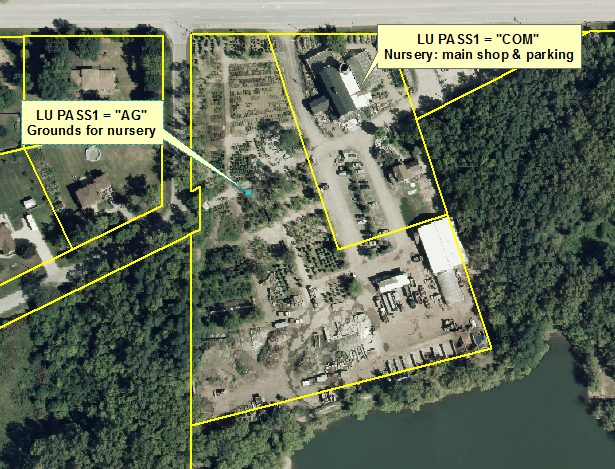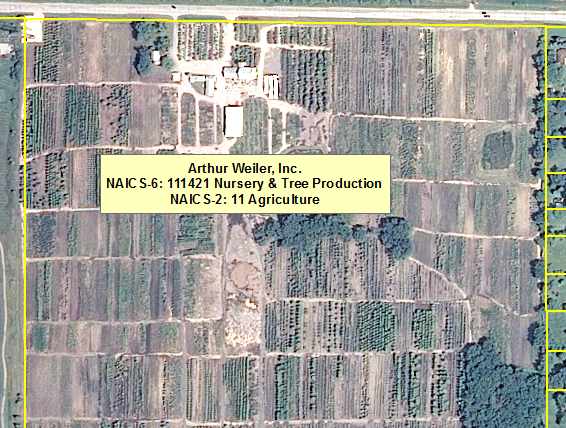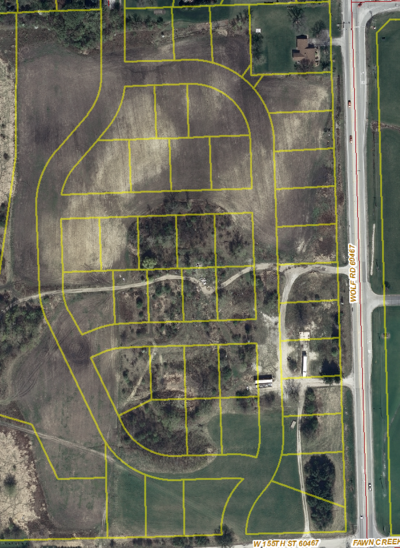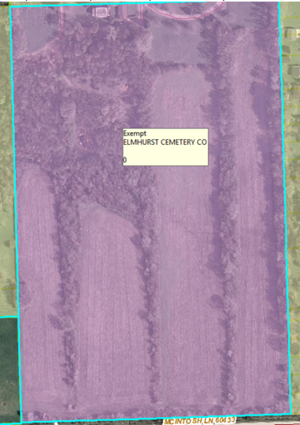Agricultural Land (2000)
Definition: Land identified in county parcel data as agricultural, where the parcel is dominated by: row crops, field crops & fallow field farms & pasture, horse, dairy, livestock, and mixed, including dairy and other livestock agricultural processing. Also includes land identified in county parcel data as having a developed land use where, according to corresponding aerial photography, the land is still in agricultural use; in those instances, the land is coded as Agriculture, with the planned land use (Residential, Commercial, Industrial, Other) identified in the PLATTED modifier.
Discussion: While the previous inventories tried to split out the “farmhouses” from the surrounding agricultural land, in this version these properties are counted as Agricultural, but with (where applicable) a RES_UNIT count of “1” applied to each parcel where, according to Assessor data, a house is present. In all counties except Cook, this determination is made during the pre-production phase and is based on the county classification code, some times used in conjunction with property value data.
With the exception of Cook County, the initial coding of Agricultural land is done through an automated procedure where all county-classified Agricultural parcels are evaluated against the USDA’s Cropland Data Layer (CDL), which is a 30-meter raster-based landcover dataset which emphasizes the classification of agricultural cover types. Through this procedure, any Ag parcel that has at least 25% crop/meadow/orchard land is automatically assigned the 2000 code. These parcels are then re-checked to ensure that there aren’t developed land uses (based on high Assessor improvement values), utility rights-of-way (query landowner for “Commonwealth Edison” or “Nicor”), and aren’t involved in mineral extraction activities (review 2005 extraction polygons). Cook County parcels will be inspected/coded individually, since there are so few.
Remaining parcels not caught during the automated procedure include:
- County-classified AG parcels which are primarily woodlots or wetlands; these should receive a code of 4100 (Vacant/Undeveloped).
- Parcels recently subdivided for a developed land use, but construction activities haven’t started yet and the actual property is still in agriculture (according to 2010 photography); these properties should recieve a code of 2000 (Agriculture), with the “Platted” field updated with the appropriate code.
Parcels on which there are stables and pastures for horses are often classified as agriculture or farm by counties. This does not mean we will necessarily code them as agriculture for land use. Below are the three usual situations encountered and the Land Use codes that will be used:
- In rural residential areas, on land owned by the same homeowner you may find horse stables and fenced areas or pastures for horses for private use only. Code these with the appropriate the Residential code for the type of housing and residential units depending on whether the housing is on the same parcel or is on an adjoining parcel with the same owner.
- If you encounter a parcel in which you find a riding center with stables, riding rings, riding exhibitions, trails, etc. where people ride horses as a private club or a public operation, code this 1240(Cultural/Entertainment).
- If you determine that horse stables and/or pasture is a commercial operation for raising, sale, boarding and/or breeding of horses, rather than one of the two above cases, you may code this 2000 Agriculture and if applicable, put a one in the RES_UNIT field.
Nurseries and greenhouses are coded based on the type of business running the operation. See Examples 1 & 2 below.
Examples:
Example 1: Nursery coded as Urban Mix (not Ag). In this case, the nursery is a business called “Prestige Nursery Garden Center”, which according to the D&B listing is a “Landscape Architectural Service” (NAICS-6 code 541320) which is lumped into the NAICS-2 category 54: Professional, Scientific and Technical Services. This is the kind of operation more consistent with an Urban Mix type of business. In this instance, the AG parcel would get coded Urban Mix.
Example 2: Nursery coded as Agriculture. On the other hand, large-scale nursery/greenhouse operations would be coded Agriculture; for the most part these will have NAICS-2 codes of “11” (Agriculture, Forestry, Fishing and Hunting). Example #2 below is a parcel with a NAICS-6 of 111421: Nursery and Tree Production.
Example 3: Agriculture with a Platted Modifier. In some cases, the 2010 aerial may show a parcel as 25% or more still as crop/meadow/orchard even though the parcel layer shows it as platted for a developed land use (Residential, Commercial, Industrial, Other). Example #3 below is an area where the parcels that are 25% or more agriculture would get coded as 2000 and those that are not would be coded vacant. The AG parcels would also need a Platted Modifier which could be obtained easily if the county land use has identified it as residential, commercial, etc. If the county codes it as unknown, then use the NDD layer to see the intended future use for an area that is currently agriculture or use the TaxName or other information to be confident in the type of future development that it will become. If you can find no information on intended use, then use Other for the Platted Modifier.
The following is a different situation in which a Platted Modifier is appropriate to use. The parcel is owned by Elmhurst Cemetery Company and is Exempt by the county. Only a tiny part of the northern most part of the parcel clips the actual cemetery. The rest is mostly cultivated farm field. Since the “active” land use by the cemetery is much too small, this will be coded 2000 Agriculture, but since it is classed as Exempt by the county, we will add the Platted Modifier of “O” for Other.
Example 4: Rural Residential. Residential Land Use in a rural setting may sometimes be classified as agriculture or farm by a county. This does not mean that we will code such parcels as agriculture. For Land Use coding, 2000 (Agriculture) will be reserved for land with crops or grazing of livestock as a commercial operation. This means someone’s large garden with no evidence this is a commercial business for them is not coded agriculture even though the county may classify the land as farm. Any parcel adjoining a house with the same owner must be evaluated as to whether it meets the Agriculture Land Use criteria of land with crops or grazing for livestock as a commercial business no matter what classification the county assigns to it. Also, a house in a rural setting on a large parcel with a private barn and horses would be coded Residential unless there is evidence that it is a commercial equestrian operation meaning they are commercially selling some equestrian-related product or service. Below are two examples of Rural Residential which would be coded Residential Land Use even though the county may classify such land as agriculture or farm. In the first photo, this Rural Residence is on 3 parcels. The small one on the far right is the house. The other two are coded by the county as farm, but there is no evidence of any commercial crop or grazing so this is coded 1111 (Single-Family Detached) with one residential unit in the parcel containing the house and zero in the other two parcels, all of which have the same owner.
In the second photo, the house is in one parcel and the private horse stables are in an adjoining parcel with the same owner. This also will be coded as Residential.
Q&A:
- Q: I’m looking at a parcel with LU pass 1 as AG. It’s part of a nursery… There are many nursery trees and bushes on this parcel along with a few buildings and bins of rock material. Do I code this as Ag … or as Urban Mix as I did the other two parcels for this nursery which were LU pass 1 of COM?
- A: These need to be handled on a case-by-case basis, depending on the type of operation. Refer to Examples 1 & 2 above.
- Q: How do I code horse stables owned by a forest preserve district; as agricultural or as open space, conservation?
- A: Code these as 3300 Open Space, Conservation.
- Q: How do I code a parcel owned by a forest preserve district that appears to be a cultivated farm field?
- A: Code this as 3300 Open Space, Conservation.
- Q: How do I code a parcel identified as AG by the county that has a farm house on it?
- A: If the parcel identified by the county as agriculture that has a house on it is 1 acre or less (43,560 sq ft) then code it 1111 Single-family detached. If the parcel is larger than that and agriculture is the appropriate code, then code it 2000 Agriculture. In both cases, make sure that there is a “1” in the residential units field.
- Q: How do I code a relatively small parcel identified by the county as AG which is next to a residential parcel with the same owner. There’s a single family detached house on the residential parcel. The AG parcel has nothing on it that in any way would suggest agriculture; nothing that looks like it’s used for horses or a large garden or anything else agricultural.
- A: Code this as 1111 Single family detached with “0” in the residential units field.
- Q: How do I code a community garden where people can rent a plot and have a garden for themselves?
- A: Code this 3100 Open Space, Recreation and instead of Agriculture because people are doing this more as a “hobby” and not as their main livelihood as would more often be the case with the Agriculture code.
- Q: Some of the parcels that were coded Ag through automation have a significant portion which is actually Mineral Extraction. Should they be left as Ag or changed?
- A: The original automated procedures had a threshold of 25%, meaning 25% of the landcover pixels falling in the parcel had to have an agricultural classification. Since Mineral Extraction is considered a “developed” land use, it carries greater land use weight, and would trump the developed land use. For these mixed parcels, recode to Mineral Extraction if at least 25% of the parcel is covered by this activity (including pits, ponds and staging areas).
- Q: How do I code an equestrian center that is mostly used for boarding horses, riding instruction, and competitions?
- A: Code this as 1240 Cultural Entertainment.
- Q: A parcel coded as AG by the county has a house on it and buildings and fencing determined by internet searches to be for dog breeding. There is no DnB point indicating a business and no evidence of a commercial sign on the property using GoogleStreetView. Do I code this as Agriculture with 1 for the residential units field?
- A: Even though the county classed this as Ag, dog breeding really does not fit our Agriculture definition. Since there is also no evidence of a commercial business, code this as ’ 1111 Single-Family Detached’ with 1 res unit.
- Q: How do I code a series of parcels owned by IDOT that appear to form what will be a future expressway? Some parcels appear to be vacant and others currently have crops on them.
- A: Code the vacant parcels 4140 Other Vacant and code the ones with at least 25% agricultural activity as 2000 Agriculture and put a O in the PLATTED Modifier field for the Ag ones.
- Q: Governors State University owns several parcels that are being farmed. They have no agriculture-related program. How should these be coded?
- A: If a parcel is entirely being farmed, then code it 2000 Agricultural. If only a portion of the university-owned parcel is being farmed, then code it 1322 Post Secondary Educational Institution.





